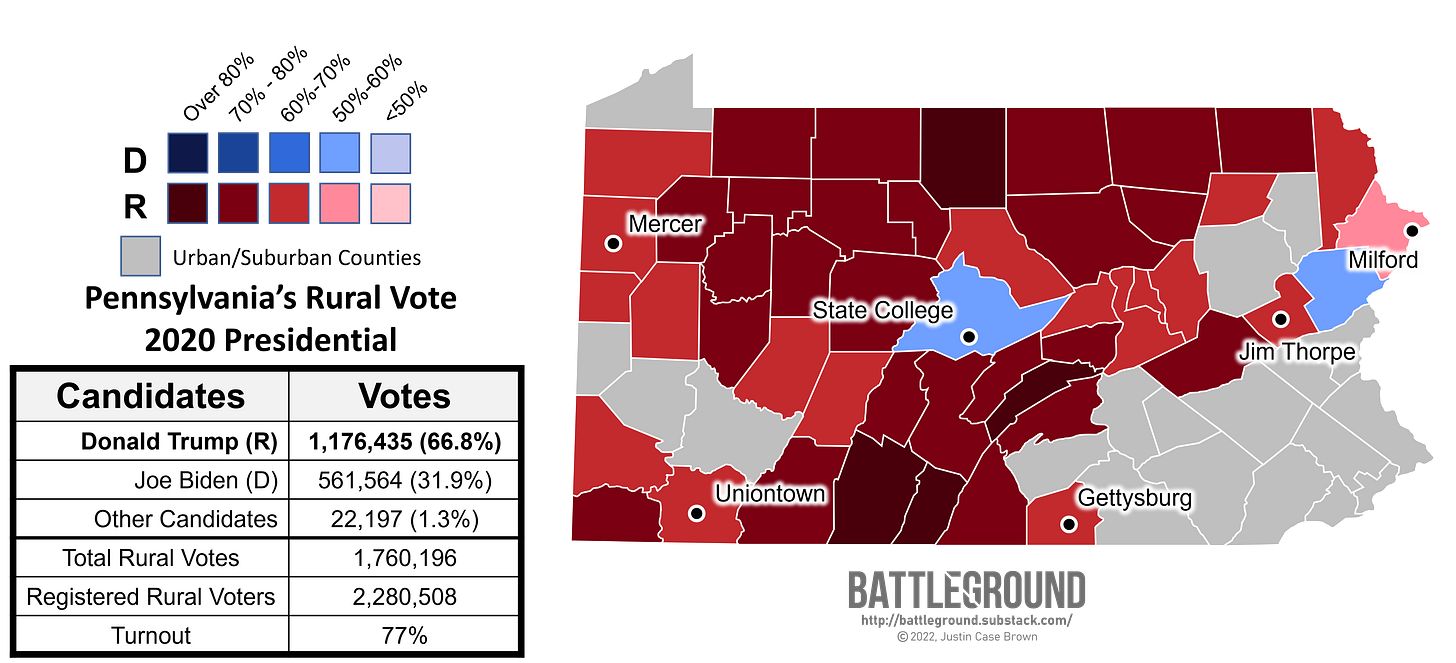Pennsyltucky, Explained
The forgotten "middle" of Pennsylvania has become an incubator for the frustrated far right.

“[As] A full-time resident of Pike County since 1991, I am far too often heartsick to see Confederate symbols displayed on local homes and vehicles and sold by area vendors. Why would those living in Pennsylvania — the “State of Independence” that lost 33,000 lives to defend the Union — want to tie themselves to so-called ‘rebels’ who fought to continue the disgrace of slavery?”
‘Pennsyltucky’ is Whiter than Kentucky
Pennsylvania has 48 rural counties: only 4 of them have substantial nonwhite populations (more than 15% nonwhite residents) and 10 rural counties are almost exclusively White (more than 95% White residents). This is a much different demographic picture than the rural south where rural residents are more racially diverse. In Pennsylvania, these White voters are also more conservative historically than their southern counterparts: even Barack Obama’s historic candidacy couldn’t flip these voters as only 4 rural Pennsylvania counties supported his first campaign in 2008. (In comparison, Obama won 24 of North Carolina’s rural counties and 29 of Georgia’s rural counties in 2008.)
Pennsylvania’s rural counties made up 25% of the total votes in the most recent presidential election and their influence is on the decline. The vast majority of rural counties saw more deaths than births recorded in the 2020 census, leading to population declines. While data shows that migration toward the state’s rural areas is healthy — more people are moving to rural PA than moving out — this migration is not meaningful enough to drive an impact as rural Pennsylvania lost 85,000 residents between the 2010 and 2020 censuses.
Democrats Have Targeted Rural PA Voters in Recent Years
Joe Biden’s 2020 campaign placed a laser focus on Pennsylvania, not only because of its electoral votes but also because Scranton, PA is Biden’s birthplace. The president campaigned heavily throughout rural Pennsylvania, explicitly seeking out persuadable moderate voters. In the end, the push resulted in ~560,000 rural votes for Biden, barely 32% of the total rural vote.
Sen. John Fetterman drove even deeper into Pennsylvania’s rural interior for his 2022 US Senate campaign and received an even less impactful payoff. While his focus on rural counties did net him a higher percentage of the rural vote than Biden (34%) this constituency only amounted to ~475,000 votes. Fetterman beat his opponent, Dr. Mehmet Oz (R) by a margin of 263,000 votes which means that Fetterman could have relinquished half of this rural vote total to Oz and would have still won the election.

For both recent Democratic winners, the keys to their success lied not in rural counties but in regional cities and suburban towns adjacent to Philadelphia and Pittsburgh. Biden managed to flip two counties in the 2020 election and Fetterman flipped six in 2022, yet only one of those counties was a rural county (and that county was Centre county, a county that regularly flips between parties due to the presence of Pennsylvania State University). If these older, white Democratic candidates who explicitly molded their campaigns to appeal to rural voters aren’t producing meaningful results… who can?
-Political Journalist Christopher Cadelago, writing about his visit to rural PA
Doug Mastriano: Rural Pennsylvania’s Mascot

The sad truth is that Pennsylvania’s rural voters don’t want compassionate moderate Democrats, they want fiery, far-right Republicans like Doug Mastriano. Mastriano’s entry into politics was through the State Senate as he currently represents the 33rd senate district, overseeing Gettysburg and its surroundings in rural Adams and Franklin counties. He rose to national prominence via his vocal opposition to the 2020 election results and became an increasingly controversial figure after securing the Republican nomination for the state’s 2022 gubernatorial race. His campaign included nods to QAnon conspiracies, misinformation surrounding Jan 6 (which he attended), and a full embrace of christian nationalism. Unsurprisingly, Mastriano’s base of support in the general election was heavily concentrated in rural Pennsylvania: while rural voters only made up a quarter of Pennsylvania’s 2022 electorate, they were responsible for close to 40% of Mastriano’s vote total.
The controversy surrounding the photo above, of Mastriano wearing a historic Confederate soldier uniform, perfectly encapsulates why rural Pennsylvania is an inhospitable landscape for Democrats. For those that need a reminder: Pennsylvania was never part of the Confederacy. (In fact, Pennsylvania is the only state that honored its Black Union soldiers following the Civil War.) Yet there’s an odd constituency of White Pennsylvanians that fly the Confederate flag and embrace the racist history of the south despite having no ancestral connections to such history. While flying the Confederate flag is arguably a racist act in the 21st century, it’s undeniably racist to fly the flag in a state that has no connection to it. Why these northerners voluntarily choose to embrace this racist symbol has never been definitively answered. (These people idiotically cite the same “historical connection” to the flag as those in the south.) But when talking about elections, the “why” doesn’t really matter here: do you seriously think rural Northerners who embrace the Confederate flag are persuadable?
Pennsylvania is a state where I believe Democrats shouldn’t be trying to organize in hopelessly ‘Trumpy’ rural areas. Rural Pennsylvania has long held a conservative-lean, almost exclusively houses White residents and the region’s political influence is waning due to population declines. Voters themselves are forcefully telling Democrats that they don’t want them here. Instead, campaigns focused on turning out base voters in and around urban areas has proven to be a winning strategy for Pennsylvania Democrats. Even the most rural-oriented candidates like Sen. John Fetterman, who ran a “every county, every vote” campaign, only won two of the state’s rural counties in the 2022 US Senate race. So while Democrats definitely deserve criticism for neglecting rural areas on a national level, rural Pennsylvania isn’t the place to start shifting strategies.



